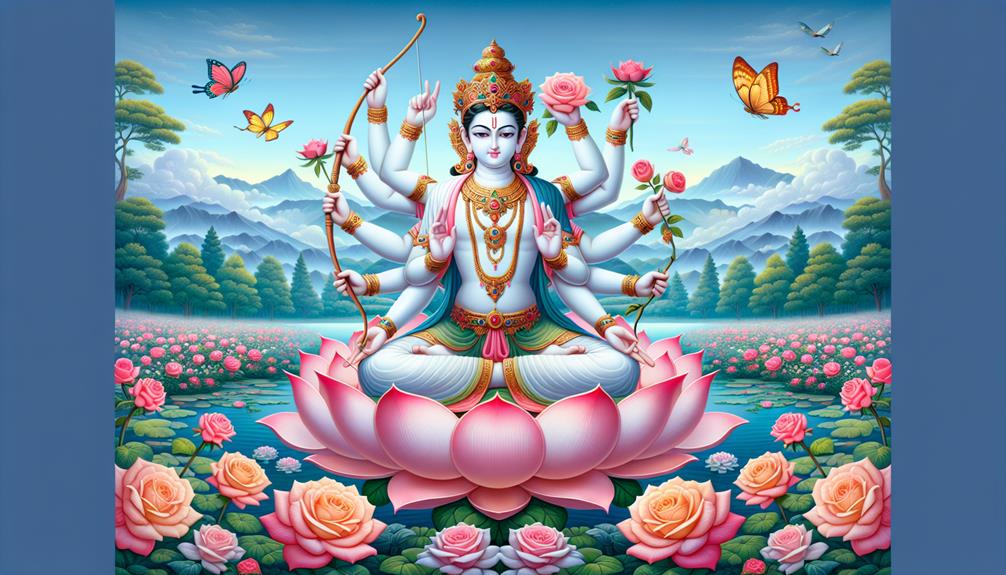Who Is Kama In Hinduism
In Hinduism, Kama is a complex deity embodying desire, love, pleasure, and longing. Known as the god of love, Kama's origins can be traced back to ancient Vedic texts, where his symbolism and significance are deeply intertwined with the fabric of Hindu mythology.
Who Is Kama In Hinduism
Revered for his role in shaping human relationships and emotions, Kama's influence extends far beyond mere physical attraction, delving into the realms of spirituality and cosmic balance. Understanding Kama's multifaceted nature offers profound insights into the complexities of human existence and the interconnectedness of all beings.
Who Is Kama In Hinduism
Key Takeaways
- Kama embodies love, desire, and attraction in Hinduism.
- His symbolism represents profound human emotions and aspirations.
- Kama plays a pivotal role in shaping destinies through love.
- Devotional practices to Kama foster emotional well-being in relationships.
Origins of Kama
The origins of Kama, a significant aspect in Hinduism, date back to ancient Vedic texts and mythology. In Hindu scriptures, Kama is often portrayed as the god of love, desire, and attraction. He is depicted as a handsome and youthful deity armed with a bow and arrows, symbolizing his ability to pierce the hearts of mortals with the arrows of desire. Kama's presence in Vedic literature highlights the importance of love and desire in the human experience, emphasizing their role in the cycle of life, creation, and procreation.
Who Is Kama In Hinduism
In Vedic texts, Kama is described as one of the key driving forces behind the universe's creation and preservation. His influence extends beyond romantic love to encompass broader aspects of life, such as creativity, passion, and motivation. The stories and myths surrounding Kama provide insights into the complexities of human emotions and relationships, offering guidance on how to navigate the intricate web of desires and attachments in the world.
Who Is Kama In Hinduism
Symbolism of Kama
Symbolizing profound aspects of human emotions and relationships, Kama in Hinduism carries rich symbolism that extends beyond mere physical attraction. Kama represents the power of desire, not just in a romantic sense, but also in a broader context of longing and aspiration. In Hindu symbolism, Kama is often depicted with a bow and flower-tipped arrows, signifying the ability to pierce the heart and ignite passion. The bow represents potential, while the arrows symbolize the different facets of desire that can influence human behavior.
Who Is Kama In Hinduism
Furthermore, Kama's presence in Hindu mythology serves as a reminder of the intricate connection between the emotional, spiritual, and physical realms. It highlights the importance of balance in navigating the complexities of desire and relationships. Kama's symbolism encourages individuals to explore the depths of their emotions and desires, recognizing them as integral parts of the human experience. By understanding and honoring the symbolism of Kama, individuals can deepen their connections with others and themselves, fostering a sense of unity and belonging within the larger tapestry of existence.
Importance in Hindu Mythology
Embodying significant roles in Hindu narratives and belief systems, Kama holds a pivotal position in Hindu mythology. Kama, the god of love and desire, plays a crucial part in various Hindu myths and epics. He is often portrayed as a handsome youth wielding a sugarcane bow and flower-tipped arrows, symbolizing the power of love to pierce even the hardest of hearts. One of the most famous tales involving Kama is his attempt to disrupt Lord Shiva's deep meditation by shooting his love arrows at him. This act ultimately led to Shiva opening his third eye and reducing Kama to ashes, highlighting the complexities of desire and its consequences in Hindu mythology.
Furthermore, Kama's presence in Hindu mythology emphasizes the importance of love, passion, and desire in the cosmic order. His actions and interactions with other deities showcase the intricate relationships and dynamics within the Hindu pantheon. Overall, Kama's significance in Hindu mythology serves to underline the enduring power and influence of love and desire in shaping both human and divine destinies.
Reverence for Kama
Kama's depiction as the god of love and desire in Hindu mythology instills a profound reverence among followers, highlighting the significant role he plays in shaping beliefs and practices within the religion. Kama is revered for his ability to ignite passion and foster emotional connections among individuals, embodying the essence of love in its purest form. The reverence for Kama extends beyond romantic love, encompassing familial bonds, friendships, and the love for the divine.
Reverence for Kama:
- Kama is seen as a divine force that brings people together, promoting unity and harmony in relationships.
- Followers believe that invoking Kama's blessings can help in strengthening emotional connections and fostering understanding between individuals.
- Many devotees express gratitude to Kama for the beauty and joy that love brings into their lives, acknowledging his role in creating meaningful and fulfilling relationships.
Kama's Influence on Relationships
In Hinduism, the influence of Kama on relationships is profound and multifaceted, shaping the emotional connections and unity among individuals. Kama, as the god of love and desire, plays a crucial role in fostering bonds not only between romantic partners but also within families and communities. The presence of Kama in relationships signifies more than just physical attraction; it embodies the essence of emotional intimacy, compassion, and understanding that are fundamental in establishing meaningful connections. Through Kama's influence, individuals are encouraged to express affection, empathy, and respect towards one another, thereby creating a harmonious environment where love can flourish.
Moreover, Kama's impact extends beyond romantic love, encompassing various forms of relationships such as friendships, filial bonds, and societal interactions. By embracing the principles of Kama, individuals can cultivate empathy, kindness, and generosity in their interactions with others, fostering a sense of belonging and unity within their social circles. Ultimately, Kama's influence on relationships emphasizes the importance of nurturing emotional connections and fostering a supportive community where individuals can experience love, understanding, and acceptance.
Frequently Asked Questions
How Is Kama Depicted in Hindu Art and Sculptures?
In Hindu art and sculptures, Kama, the god of love, is often depicted as a youthful figure with bow and arrows, symbolizing his ability to ignite desire in the hearts of beings.
He is usually portrayed riding a parrot, a vehicle associated with love and passion.
Kama's presence in art serves to represent the power of love and attraction in Hindu mythology, embodying the essence of desire and longing.
Are There Any Specific Rituals or Prayers Dedicated to Honoring Kama in Hinduism?
Are there specific rituals or prayers dedicated to honoring Kama in Hinduism?
Various rituals and prayers exist in Hinduism that pay homage to different deities and aspects of life, including love and desire, which Kama represents.
Devotees often engage in ceremonies, pujas, and recitation of mantras to seek blessings and guidance in matters related to love, relationships, and emotional well-being.
These practices reinforce the importance of Kama in Hindu belief systems.
What Are Some Lesser-Known Stories or Myths Involving Kama in Hindu Scriptures?
Some lesser-known stories or myths involving Kama in Hindu scriptures include his role in the tale of Shiva burning him to ashes with his third eye, and his subsequent rebirth.
Another story involves Kama aiding the gods in their battle against the demon Tarakasura.
These narratives highlight Kama's significance in Hindu mythology beyond his well-known role in love and desire.
How Has the Concept of Kama Evolved Over Time in Hinduism?
The concept of Kama in Hinduism has evolved significantly over time, transitioning from merely representing physical desires to encompassing a broader spectrum of emotions and connections.
Initially associated with sensuality, Kama has transformed into a more holistic view that includes emotional, spiritual, and intellectual aspects of human relationships.
This evolution showcases the depth and complexity of Kama's role in shaping human interactions and the understanding of desires within the Hindu philosophical framework.
Are There Any Specific Temples or Shrines Dedicated to Kama in India?
There are specific temples or shrines dedicated to Kama in India. These sacred sites serve as places of worship and pilgrimage for devotees seeking blessings related to love, desire, and relationships.
The rituals and offerings performed at these locations are believed to invoke the divine presence of Kama, fostering harmony and fulfillment in matters of the heart. These temples hold significance for those seeking guidance and support in matters of love and passion.
Conclusion
The concept of Kama in Hinduism is deeply rooted in the mythology and symbolism of the religion. Originating from ancient texts, Kama represents desire, love, and passion, playing a significant role in shaping relationships and human interactions.
The reverence for Kama highlights its importance in Hindu culture and the influence it has on personal connections. Through exploring the origins and symbolism of Kama, one can gain a deeper understanding of its significance in Hindu mythology.

